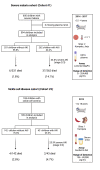Renin as a Biomarker of Acute Kidney Injury and Mortality in Children With Severe Malaria or Sickle Cell Disease
- PMID: 37842390
- PMCID: PMC10569743
- DOI: 10.7759/cureus.45124
Renin as a Biomarker of Acute Kidney Injury and Mortality in Children With Severe Malaria or Sickle Cell Disease
Abstract
Background: Globally, a very high percentage of acute kidney injury (AKI) occurs in low- and middle-income countries (LMICs) where late recognition contributes to increased mortality. There are challenges with using existing biomarkers of AKI in LMICs. Emerging evidence suggests renin may serve as a biomarker of kidney injury that can overcome limitations in creatinine-based diagnostics.
Methods: Two study populations in Uganda were assessed. Cohort #1 was a two-site, prospective cohort study enrolling 600 children with severe malaria (SM). Cohort #2 was a prospective cohort study enrolling 185 children with sickle cell disease (SCD) hospitalized with a vaso-occlusive crisis. Plasma or serum renin concentrations were measured in both cohorts of children at the time of hospital admission using Luminex® (Luminex Corporation, Austin, Texas, United States) or enzyme-linked immunosorbent assay (ELISA), respectively. We assessed the ability of renin to discriminate between children with or without AKI and between children who survived and children who died using receiver operating characteristic curves.
Results: In both cohorts, renin concentrations were strongly associated with AKI and mortality. Renin was able to discriminate between children with or without AKI with an area under the curve (AUC) of 0.70 (95%CI, 0.65-0.74) in children with SM and 0.72 (95%CI, 0.6co3-0.81) in children with SCD. Renin was able to discriminate between children who survived and children who died with an AUC of 0.73 (95%CI, 0.63-0.83) in children with SM and 0.94 (95%CI, 0.89-0.99) in children with SCD. In Cohort #2, we compared renin against urine neutrophil gelatinase-associated lipocalin (NGAL) as the leading biomarker of AKI, and it had comparable performance in discriminating AKI and predicting mortality.
Conclusions: In two independent populations of children at risk of AKI with key differences in the etiology of kidney injury, renin was strongly associated with AKI and mortality and had moderate to good diagnostic performance to predict mortality.
Keywords: acute kidney injury; mortality; renin; severe malaria; sickle cell disease.
Copyright © 2023, Adan Jr. et al.
Conflict of interest statement
The authors have declared that no competing interests exist.
Figures


References
-
- KDIGO clinical practice guideline for acute kidney injury. Kidney Int Suppl. 2012;2:1–138.
-
- Sepsis-associated acute kidney injury: consensus report of the 28th Acute Disease Quality Initiative workgroup. Zarbock A, Nadim MK, Pickkers P, et al. Nat Rev Nephrol. 2023;19:401–417. - PubMed
Grants and funding
LinkOut - more resources
Full Text Sources
Miscellaneous
